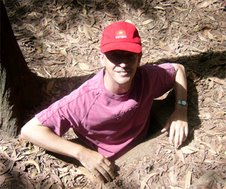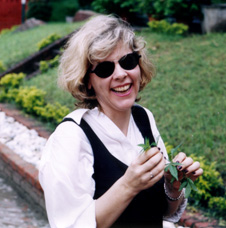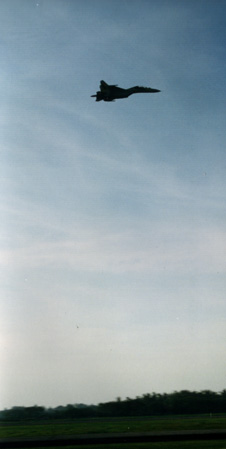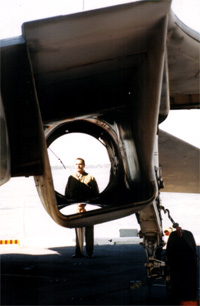In 2005 David Paton, good friend, mentor, example, and inspiration died after experiencing an aggressive cancer. I flew to New Zealand to attend his funeral. On the flight back I started writing some notes that were intended to capture something of what David meant to me. Taking a deep breath I thought I would share them more widely here on this blog. They are less coherent than I would like but they tell a story of what a difference one life, honestly lived, can make to those around them. These notes are offered up in 15 chapters which I will post out over the next few weeks. And in order that you can put a face to a name, here he is, on the Stewart Island ferry, catching some "zeds". Or "zees" depending on what part of the world you hail from.
 The pet possum was a rare animal, treated with compassion and given a citizenship in the house that few other animals ever had. Ordinarily the Australian brush possum is hunted without respite, it being a noxious pest in New Zealand, causing millions of dollars of damage to forestry and agricultural resources every year. They are hunted with a passion and were the source of some pocket money as we grew up. Out on the Run, with the dogs loose it only required a whispered “sic ‘em” to have a pack of half a dozen dogs or so (sometimes more) to get their blood up and to tear off towards the nearest outcrop of rock to hunt out a possum. Whether there was one resident there or not. David would amble along behind to see what would flush out but often he was the one grabbing this or that dog and force feeding it down a hole or crevice. Sometimes a possum would flush or sometimes a possum would deter the dog with a well aimed swipe at the nose. Sometimes there was only a lot of noise, dust, and slow grins and absolutely no possum to show for the hunt. One possum escapade was especially memorable. It was at Waihola. On that place there was a very old woolshed. At one end there was a lean-too structure which was only a single story high, with a corrugated roof. Somehow we had learned there was a possum resident in the roof but we were unable to flush it out. With a ceiling pinned to the reverse side of the rafters there were plenty of places for it to hide and no way for us to see in. David’s solution was to pick up one of his scrawniest dogs (he used to bring a selection of them down to Waihola, and in the days prior to the purchase of the truck they would all be piled into that old Ford) and stuff it under a loose bit of corrugated iron on which he would then stand to prevent the dog reversing out. Hardly any need since every dog knew that a hunt was on with the cue “sic ‘em” and the place stank of the possum in any event. There was a huge commotion from within the roof as the dog scrambled around in the dark, barking and yelping and the possum growled and shrieked. I have no idea how the possum got out but remember being surprised at its appearance as a dark blur evacuating from under the guttering, flying across the yard and scrambling up the trunk of a huge old macrocarpa tree nearby. Its second mistake was to pause to look around and get its bearings. David shot it dead. We then spent some effort in extracting the dog from under the iron and I recall a few sheets having to be lifted. That old woolshed came down a few years later and was replaced by a new structure that did not leak but had none of the adventure in it that its collapsing possum ridden predecessor had.
The pet possum was a rare animal, treated with compassion and given a citizenship in the house that few other animals ever had. Ordinarily the Australian brush possum is hunted without respite, it being a noxious pest in New Zealand, causing millions of dollars of damage to forestry and agricultural resources every year. They are hunted with a passion and were the source of some pocket money as we grew up. Out on the Run, with the dogs loose it only required a whispered “sic ‘em” to have a pack of half a dozen dogs or so (sometimes more) to get their blood up and to tear off towards the nearest outcrop of rock to hunt out a possum. Whether there was one resident there or not. David would amble along behind to see what would flush out but often he was the one grabbing this or that dog and force feeding it down a hole or crevice. Sometimes a possum would flush or sometimes a possum would deter the dog with a well aimed swipe at the nose. Sometimes there was only a lot of noise, dust, and slow grins and absolutely no possum to show for the hunt. One possum escapade was especially memorable. It was at Waihola. On that place there was a very old woolshed. At one end there was a lean-too structure which was only a single story high, with a corrugated roof. Somehow we had learned there was a possum resident in the roof but we were unable to flush it out. With a ceiling pinned to the reverse side of the rafters there were plenty of places for it to hide and no way for us to see in. David’s solution was to pick up one of his scrawniest dogs (he used to bring a selection of them down to Waihola, and in the days prior to the purchase of the truck they would all be piled into that old Ford) and stuff it under a loose bit of corrugated iron on which he would then stand to prevent the dog reversing out. Hardly any need since every dog knew that a hunt was on with the cue “sic ‘em” and the place stank of the possum in any event. There was a huge commotion from within the roof as the dog scrambled around in the dark, barking and yelping and the possum growled and shrieked. I have no idea how the possum got out but remember being surprised at its appearance as a dark blur evacuating from under the guttering, flying across the yard and scrambling up the trunk of a huge old macrocarpa tree nearby. Its second mistake was to pause to look around and get its bearings. David shot it dead. We then spent some effort in extracting the dog from under the iron and I recall a few sheets having to be lifted. That old woolshed came down a few years later and was replaced by a new structure that did not leak but had none of the adventure in it that its collapsing possum ridden predecessor had.
Standing on the high country of the Run on a snowy day I paused with David and watched the “bread bus” making its way along the pigroot. David had stopped striding across the tussock to point out that the bus was travelling way too fast on a road covered with ice (he would know) and only opened that morning by the council grader. He suggested we watch it disappear around a bend on the side of the distance spur, across the gully and in the far distance and see if it reappeared on the road further down the valley. “My bet” said David, “is that we don’t see it reappear.” And we didn’t. An hour later we edged our way carefully back up that same bend and found the bus on its side in the snow. The driver seemed very nonplussed and was sitting in the snow drinking from a thermos flask and making wise cracks about the mail not getting through. But as we chatted we realised he was very shaken – as he had swung around the bend only seconds after vanishing from our view he had lost control and was heading for a dramatic drop into the creek below. Somehow he had wrested his careening vehicle to the other side of the road where he had deliberately aimed for the ditch in an effort to get the thing to stop. We left him in the snow and ice, in the rapidly dropping ice blue shadow of the end of the day and said we would call the council to see if he could get him towed out. An hour later the grader came through and about an hour later the bus crept past David’s house, somewhat chastened no doubt.
We left the Run late one night in pouring rain. We had been up there at midnight in late spring, shooting rabbits using a spotlight. The booming .303 was something of an overkill, deafening those in the cabin and proving to be more of a fun factor than anything else. I can still hear Steve saying “Bruce, put that thing away!” as the muzzle flash lit up the night and the thunder of the shot cracked across the gullies. The rain increased to a point where, even if there was a rabbit out there we would be hard pressed to see it so we departed the top of the Run and headed down to the highway. Travelling back to David’s place, as we drove up a long gentle slope in the highway a rabbit hopped out onto the road just at the edge of the headlights. Not in any hurry but just edging along in a slow lope. David asked me to pass over the .303 which I did. Leaning out the driver’s window he proceeded to blast ten rounds up the highway. One hand still on the wheel. Chunks of Highway 75 were flung into the night but the rabbit continued its slow lope, seemingly oblivious to the noise behind it and the destruction around it. In the end it hopped into the verge and stopped after which we duly dispatched it from a distance of only inches. The “one shot, one horse” legend was in tatters!
But not so much that I ever failed to appreciate his praise for my shooting. Getting a pat on the back from David was rare but when it came it was very special. Once at Waihola he took about five or six of us kids up to what was then known as the CYC paddock, the only patch of green grass on the place. From a high vantage point we looked down onto a large puddle on which was floating a thin stick, about half an inch thick and barely visible. About 75 yards away he said. Giving us all one round he then handed his rifle to one of the group and asked us to hit the stick. One after another twig was bounced around in the water until I was handed the rifle. Taking quick aim and dropping the sights on it I fired the round and the twig became two. David was impressed. I savoured that praise for years.
Previous Post
 My boyhood years were spent with my siblings in small rural town in Otago, New Zealand. More rural than town, our upbringing had a Huck Finn flavour about it in some respects. A well established and fond memory are the "contraptions" built by one of the brothers, the building of one being distilled in this (very) short story.
My boyhood years were spent with my siblings in small rural town in Otago, New Zealand. More rural than town, our upbringing had a Huck Finn flavour about it in some respects. A well established and fond memory are the "contraptions" built by one of the brothers, the building of one being distilled in this (very) short story.




























